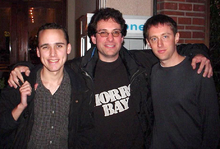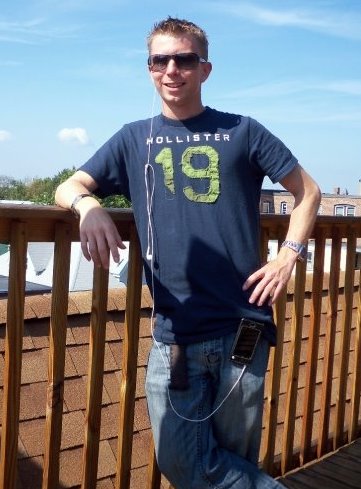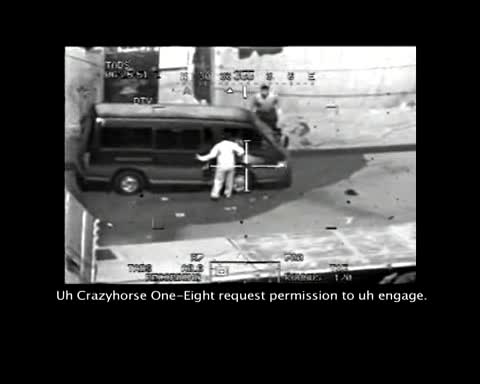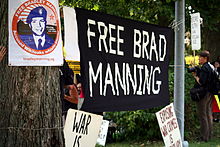|
BRADLEY MANNING SUPPORT NETWORK MILITARY PILES ON 22 MORE CHARGES
INCLUDING DEATH PENALTY The Army private suspected of stealing the trove of classified documents published by WikiLeaks was hit Wednesday with 22 new charges - including one punishable by death. However, Army prosecutors says they will not recommend that Pfc. Bradley Manning be executed. The 23-year-old former intelligence analyst in Iraq has been held in solitary at a Marine base in Virginia since his arrest in May. Manning had been charged with transferring classified data to his computer and disclosing classified information "with reason to believe that the information could cause injury to the United States." Among the 22 new charges is "aiding the enemy" - normally a capital offense. In keeping with the egocentric nature of WikiLeaks' leadership, the WikiLeaks Twitter account posted a message saying the charge "suggests WikiLeaks will be defined as 'the enemy.' A serious abuse." Other new charges against Manning include theft of public records, transmitting defense information and computer fraud. "The new charges more accurately reflect the broad scope of the crimes" that Manning is accused of, said Capt. John Haberland, legal spokesman for the Military District of Washington. Manning was arrested last year after bragging to notorious hacker Adrian Lamo that he stole thousands of classified documents from secure government computers in Iraq, transferring the secret files to rewritable discs labeled Lady Gaga. Manning said he "lip-synced to Lady Gaga's 'Telephone" while exfiltratrating possibly the largest data spillage in American history." He did it partly out of boredom and partly from a conviction that "information should be free," he said.�� more... BACKGROUND INFORMATION ON THE SADISTIC
AMERICAN LIQUIDATION OF BRADLEY MANNING Bradley E. Manning (born December 17, 1987) is a United States Army soldier who was arrested in May 2010 in Iraq on suspicion of having passed classified information to the whistleblower website WikiLeaks. He was charged in July that year with transferring classified data onto his personal computer, and communicating national defense information to an unauthorized source between November 19, 2009, and May 27, 2010. An additional 22 charges were preferred in March 2011, including "aiding the enemy," a capital offense, though prosecutors said they would not seek the death penalty. He is currently awaiting a hearing to decide whether he will face a court martial.[2] Manning had been assigned in October 2009 to a support battalion with the 2nd Brigade Combat Team, 10th Mountain Division, based at Forward Operating Base Hammer, Iraq. There he had access to the Secret Internet Protocol Router Network (SIPRNet), used by the United States government to transmit classified information. He was arrested after Adrian Lamo, an American computer hacker, reported to the FBI that Manning had told him during online chats in May 2010 that he had downloaded material from SIPRNet and passed it to WikiLeaks, which had begun publishing it in February.[3] The leaked material is said to have included over 250,000 United States diplomatic cables, the first of which WikiLeaks published in February 2010, with newspapers publishing the rest from November that year onwards; Apache gunsight footage of the July 12, 2007, Baghdad airstrike, published by WikiLeaks in April 2010 as the "Collateral Murder" video; and F-18 gunsight footage of the Granai airstrike in Afghanistan, which WikiLeaks said it intended to release.[3] After his arrest, Manning was flown out of Iraq and detained in a military jail in Kuwait. He was transferred to the United States in July 2010, and since then has been held in "maximum custody" solitary confinement at the Marine Corps Brig, Quantico, Virginia, awaiting medical reports and a pre-trial hearing.[4] Amnesty International expressed concern in January 2011 about the conditions in which he is being held, calling them harsh and punitive.[1]
BackgroundEarly life and educationManning and an older sister were born in Crescent, Oklahoma, to an American father, Brian Manning, and his wife, Susan Fox, who was born in 1953 in Haverfordwest, Wales.[1] His father had been in the United States Navy for five years, and his parents met when his father was stationed in Wales at Cawdor Barracks. Manning was raised in Crescent, where his father worked as an IT manager for a rental car agency. He was small for his age�as an adult, he reached just 5 ft 2 ins and weighed 105 lbs�good at the saxophone and science, and even in elementary school had talked about wanting to join the U.S. Army. One teacher told reporters, "He was very, very smart. He was also very opinionated�but only up to a point. He never got in trouble." He enjoyed playing computer games and was one of the few people in his community who openly rejected religion. David Leigh and Luke Harding write that he would refuse to do homework related to the Bible, and remained silent during the reference to God in the Pledge of Allegiance. His father was reportedly very strict with him, which Leigh and Harding write may have contributed to his becoming introverted and withdrawn, which they say deepened when he began to realize at age 13 that he was gay.[5] 
High Street in
Haverfordwest, Wales, where Manning went to
secondary school.
One neighbor said his mother had difficulty adjusting to life in the U.S., and his father was often away, so Manning was largely left to fend for himself.[6] His parents divorced when he was 13, and he moved with his mother to Haverfordwest, Wales.[2] He was the only American at his new school, Tasker Milward.[5] He reportedly became known for having an attitude, and as a "hot-headed" computer nerd, spending lunch times at the school's computer club, building his own website.[4] Tom Dyer, who was at Tasker Milward with him, told Britain's Channel 4 News that, "If something went wrong, [Manning] would speak up about it if he didn't agree with something. He would even have altercations with teachers if he thought something was not right." Dyer said Manning was bullied because he was an American; other students would impersonate his accent and mannerisms.[7] He was also targeted for being effeminate; Denver Nicks writes that he had told his schoolfriends in Oklahoma that he was gay, but he was not open about it at school in Wales.[2] He returned to the United States after sitting his GCSEs, moved in with his father and sister in Oklahoma City, and took a job with a software company, Zoto, but he fell out with his dad over his sexuality, and was asked to leave home.[8] He moved in with a friend in Tulsa, where he took low-paid jobs with Incredible Pizza Company and F.Y.E., a music store.[2] He apparently also lived in his car for a time.[6] Nicks writes that he then moved to Chicago, and later went to live with his aunt, Debra Van Alstyne, in Potomac, Maryland, where he took classes at a local college, and worked for Starbucks, and Abercrombie and Fitch.[2] Enlistment in the U.S. Army and transfer to IraqHe enlisted in the army in October 2007, doing his basic training at Fort Leonard Wood, Missouri, and after graduating in April 2008 moved to Fort Huachuca, Arizona, where he trained as an intelligence analyst. Nicks writes that he was reprimanded while there for posting messages to friends on YouTube that apparently revealed sensitive information.[2] In August 2008, he was sent to Fort Drum in Jefferson County, New York, where he waited to be sent to Iraq.[9] It was there in the fall of 2008 that he met Tyler Watkins, with whom he had his first serious relationship, posting happily on Facebook about it. Nicks writes that it appears to have ended by September 2009, though Leigh and Harding say it ended around May 5, 2010.[10] Watkins was studying neuroscience and psychology at Brandeis University near Boston, and Manning would regularly travel there to visit him. It was at Brandeis that he was introduced to Watkins's network of friends, and the university's hacker community, as well as its ideas about the importance of information being free. He visited the university's "hackerspace" workshop, and met David House, the computer scientist and MIT researcher who has been allowed to visit him in jail twice a month, the only person apart from his lawyer with permission to do so.[9] In October 2009, Manning was sent to Iraq to work for the 2nd Brigade Combat Team of the 10th Mountain Division, based at Forward Operating Base Hammer, near Baghdad. He seems not to have been happy there. According to ABC News, he was reprimanded for assaulting another soldier, demoted from Specialist to Private First Class, and sent to a chaplain after officers noticed what ABC said were "odd behaviors." When he introduced himself by e-mail to Adrian Lamo in May 2010 he wrote that he was about to be discharged from the army because of what he called an adjustment disorder.[11] Alleged disclosure of classified materialWikiLeaks
Further information:
Information published by WikiLeaks

Julian Assange and
Daniel Domscheit-Berg at the
Chaos Communication Congress, Berlin,
December 2009. It was Assange who had the idea
in 2006 of creating an open-source, democratic
intelligence agency.[12]
WikiLeaks was set up in late 2006 as a disclosure portal, initially using the Wikipedia model, where volunteers would write up and analyze classified or restricted material submitted by whistleblowers, or material that was in some other way legally threatened. It was Julian Assange�an Australian with a background in computer hacking, and the de facto editor-in-chief of WikiLeaks�who had the idea of creating what he saw as an "open-source, democratic intelligence agency." The wiki element was abandoned, but the site remained open for the anonymous submission of leaked documents, using OpenSSL, FreeNet, PGP, and Tor. According to Leigh and Harding, one of its early volunteers owned a server that was being used as a Tor exit node, and noticed that Chinese hackers were using Tor to gather information from foreign governments. He began to collect the information himself, and this allowed WikiLeaks to announce when it began publishing in December 2006 that it had one million documents from over 13 countries.[12] Manning told Lamo during their online chats in May 2010 that he had developed a relationship with Assange, but knew little about him. Lamo alleged in later interviews that Manning said he had communicated directly with Assange using an encrypted Internet conferencing service, and that Assange had "coached" him regarding what to send and how to do it. Lamo is the only source of these allegations; he said these statements from Manning were in the unpublished parts of the chat logs, but that the FBI had taken his hard drive so he no longer had access to the rest. The New York Times wrote in December 2010 that the U.S. government was trying to discover whether Assange had been a passive recipient, or had encouraged or helped Manning to extract the files; if the latter, Assange could be charged with conspiracy. WikiLeaks did not identify Manning as the source of the material�the Apache helicopter video credited "our courageous source"�and according to NBC News in January 2011, the U.S. government could find no evidence that Manning had any direct contact with Assange.[13] Daniel Domscheit-Berg, a former WikiLeaks spokesman, wrote in 2011 that part of the WikiLeaks security concept was that they did not know who their sources were; they simply satisfied themselves before publishing that there was a public-interest reason to do so.[14] Manning's access to SIPRNet, material released by WikiLeaks
Manning reportedly told Lamo he found the "Collateral
Murder" video in late 2009, and passed it to
WikiLeaks in February 2010.
Manning is said to have first contacted WikiLeaks in November 2009, days after it posted 500,000 pager messages from the September 11, 2001, attacks.[15] From his workstation in Iraq, Manning had access to SIPRNet and the Joint Worldwide Intelligence Communications System, and in late 2009 he found the Apache helicopter video. He told Lamo: "At first glance it was just a bunch of guys getting shot up by a helicopter. No big deal ... about two dozen more where that came from, right? But something struck me as odd with the van thing, and also the fact it was being stored in a JAG officer�s directory. So I looked into it."[3] In January 2010, while on leave in Boston, he told Tyler Watkins he had found some sensitive information and was considering leaking it.[3] During the same month he began posting on Facebook in a way that suggested he was upset about something. According to The Daily Telegraph, he wrote that "Bradley Manning didn't want this fight. Too much to lose, too fast," and said he was livid after being "lectured by ex-boyfriend."[16] On February 18, WikiLeaks posted the first of the material that allegedly came from him, a diplomatic cable dated January 13, 2010, from the U.S. Embassy in Reykjavik, Iceland�a document that came to be known as Reykjavik13. In the chat log, Manning called this a "test" document.[2] On March 15, WikiLeaks posted a 32-page report written in 2008 by the U.S. Department of Defense about WikiLeaks itself. On March 29, it posted U.S. State Department profiles of politicians in Iceland.[17] On April 5, it published the Apache helicopter video of the July 12, 2007, Baghdad airstrike, which Manning is alleged to have passed on in February; WikiLeaks called it the "Collateral Murder" video, and it attracted widespread coverage. On July 25, it released the Afghan war documents, and in October the Iraq War documents, internal military war logs and diaries. Manning is also alleged to have given them 251,287 U.S. state department cables�written by 260 embassies and consulates in 180 countries�which were passed by Assange to several news organizations. They were published in stages, the first by WikiLeaks in February 2010 (the Reykjavik13 document), then from November 29 that year by The New York Times, Der Spiegel, The Guardian, El Pa�s, and others. WikiLeaks said it was the largest set of confidential documents ever released into the public domain.[18] Manning's chats with Adrian LamoOn May 20, 2010, Manning is alleged to have contacted Adrian Lamo, a former hacker who had been profiled that day in Wired magazine by Kevin Poulsen after being hospitalized and diagnosed with Asperger's Syndrome. Poulsen is himself a former computer hacker who had used Lamo as a source several times over the years.[19] Lamo told Glenn Greenwald that Manning sent him several encrypted e-mails after seeing a tweet Lamo had posted about WikiLeaks; Lamo was unable to decrypt the correspondence because Manning had, Lamo said, "encrypted it to an outdated PGP key of mine." Lamo told Greenwald he replied anyway, not knowing who the e-mails were from or what they said, and invited the e-mailer to chat on AOL IM, offering his screen name. Manning sent him some more e-mails, also encrypted; Lamo said he later turned these and the earlier e-mails over to the FBI without having read them.[20] In a series of chats from May 21 until May 25/26�around 20 percent of which were published by Wired and The Washington Post�Manning, using the handle "Bradass87," apparently told Lamo that he had leaked classified material.[21] He introduced himself as "an army intelligence analyst, deployed to eastern Baghdad, pending discharge for 'adjustment disorder.'"[22] He asked Lamo:
The next day he told Lamo he felt isolated:
He said he had been leaking files to a "white-haired Aussie" (The Washington Post),[22] and on May 25 said "i want people to see the truth� regardless of who they are ... because without information, you cannot make informed decisions as a public (Wired).[23] On the same day, he said the incident that "got [him] the most" was when 15 detainees were arrested by the Iraqi Federal Police for printing anti-Iraqi literature. He was asked by the army to investigate who the "bad guys" were, as he told Lamo. He said he discovered the detainees had printed what he called a scholarly critique of the Iraqi prime minister, one called "Where did the money go?" that followed what Manning said was a corruption trail within the Iraqi cabinet. He reported this to his commanding officer, but said "he didn't want to hear any of it"; he said the officer told him to help the Iraqi police find more detainees. Manning said he realized, "i was actively involved in something that i was completely against ..." (Wired). He told Lamo he had erased CD-RWs containing Lady Gaga songs, and rewritten them with the downloaded documents (Wired).[23]
He asked Lamo "I mean what if I were someone more malicious":
He said he hoped the material would lead to "worldwide discussion, debates, and reforms," and if not we're "doomed as a species ... I will officially give up on the society we have if nothing happens" (Wired).[23] He said he felt encouraged by the response to the Baghdad airstrike video: "the reaction to the video gave me immense hope ... CNN�s iReport was overwhelmed ... Twitter exploded ..." (Wired).[23] He said Secretary of State Hillary Rodham Clinton "and several thousand diplomats around the world are going to have a heart attack when they wake up one morning, and finds an entire repository of classified foreign policy is available, in searchable format to the public ... everywhere there's a US post ... there's a diplomatic scandal that will be revealed" (The Washington Post).[22] He wrote: "I want people to see the truth regardless of who they are because without information, you cannot make informed decisions as a public" (Wired).[23]
Lamo's approach to the FBI, partial publication of the chat logs
Adrian Lamo (left) and Wired's
Kevin Poulsen (right), photographed in 2001
with former computer hacker
Kevin Mitnick
Lamo told Wired he had given money to WikiLeaks in the past, and that the decision to go to the authorities had not been an easy one. He said he believed lives were in danger: "[Manning] was in a war zone and basically trying to vacuum up as much classified information as he could, and just throwing it up into the air." Lamo said he had offered journalist-source anonymity to Manning during the chats, but he approached federal agents shortly after their first chat.[20] Jonathan V. Last wrote that Lamo discussed what Manning had told him with Chet Uber of the volunteer group, Project Vigilant, which researches cyber crime, and Uber reportedly told Lamo to go to the FBI. On May 25, Lamo met with FBI and Amy CID officers at a Starbucks near his home in California, where he showed them the chat logs. He met them again on May 27, at which point they told him Manning had been arrested in Iraq the day before.[3] The news of his arrest was broken on June 6 by Wired reporter Kevin Poulsen, who had written the May 20 Wired profile of Lamo. Daniel Domscheit-Berg described it as the worst moment in the history of WikiLeaks.[24] Wired published around 25 percent of the chat logs on June 6 and June 10, saying the remainder either infringed Manning's privacy or compromised sensitive military information. Ellen Nakashima of The Washington Post published excerpts on June 10, and on June 19 BoingBoing published what it said was a more complete version.[25] Glenn Greenwald, writing in Salon in December 2010, called the failure to publish the logs in full "easily one of the worst journalistic disgraces of the year," writing that Poulsen and Wired had helped conceal the truth about the arrest. "In doing so," he argued, "they have actively shielded Poulsen's longtime associate, Adrian Lamo�as well as government investigators�from having their claims about Manning's statements scrutinized, and have enabled Lamo to drive much of the reporting of this story by spouting whatever he wants about Manning's statements without any check."[25] In response, Wired's editor, Evan Hansen, wrote that the logs included sensitive personal information that had no bearing on WikiLeaks, and that it would serve no purpose to publish them. "That doesn�t mean we�ll never publish them," he wrote, "but before taking an irrevocable action that could harm an individual�s privacy, we have to weigh that person�s privacy interest against news value and relevance."[26] Criminal proceedingsArrest and charges
Manning was arrested on May 26, 2010, and was at first held in a military jail at Camp Arifjan in Kuwait.[27] He was charged on July 5 under the Uniform Code of Military Justice (UCMJ) with violations of UCMJ Articles 92 and 134 for "transferring classified data onto his personal computer and adding unauthorized software to a classified computer system in connection with the leaking of a video of a helicopter attack in Iraq in 2007," and "communicating, transmitting and delivering national defense information to an unauthorized source and disclosing classified information concerning the national defense with reason to believe that the information could cause injury to the United States."[28] He was also one of those named in the Twitter subpoena later in December, when the U.S. government tried to obtain access to the Twitter accounts of several of those involved.[29] On March 2, 2011, an additional 22 charges were preferred, including wrongfully obtaining classified material for the purpose of posting it on the Internet, knowing that the information would be accessed by the enemy; the illegal transmission of defense information; fraud; and aiding the enemy. CBS reported that the new charges involved the leaking of the Afghan and Iraq war logs, and a quarter of a million State Department cables; according to ABC News, the charge sheets said Manning had transferred 380,000 records about Iraq, and 90,000 about Afghanistan. In all, CBS said, he is accused of having leaked over half a million documents and two videos. Prosecutors told Manning's lawyers they would not seek the death penalty, though the charge of aiding the enemy is a capital offense. They said if convicted he will face life imprisonment, reduction in rank to the lowest enlisted pay grade, a dishonorable discharge, and loss of pay and allowances.[30] DetentionOn July 29, 2010, he was moved from Kuwait to a military jail in Quantico, Virginia, and classified as a "maximum custody detainee." Amnesty International wrote in January 2011 to the U.S. Secretary of Defense about his detention, writing that he was being held in a 72-square-foot cell, with no window, furnished only by a bed, toilet and sink, with meals taken in his cell, no contact with other pre-trial detainees, and with one hour outside the cell every 24 hours for exercise. There was access to a television when it was placed for limited periods in the corridor just outside his cell, and he was allowed to keep one book and one magazine in his cell�according to Leigh and Harding, one book he requested was Immanuel Kant's Critique of Pure Reason�but otherwise no writing materials, though access to them was given during allotted times. He was being shackled during attorney and family or social visits.[31] In addition to the maximum-custody conditions, Amnesty wrote that he was being held under a "Prevention of Injury" (PIA) assignment, which entailed checks by guards every five minutes, and no sleeping during the day; his lawyer David Coombs�a former serviceman and military attorney�said he was not allowed to sleep after 5 am, and if tried to, he was made to stand or sit up. Amnesty wrote that the PIA assignment also involved him remaining visible at all times, including at night. This meant he had no access to sheets or a separate pillow; he was required at that time to sleep in boxer shorts, and had experienced chafing of the skin from heavy blankets.[31] David House, the computer scientist who is allowed to visit him twice a month, told reporters in December 2010 that Manning's mental and physical health were deteriorating.[32] In March 2011, officials told The New York Times that Manning would be required to sleep without clothing, and to present himself naked outside his cell for morning inspection, to ensure that he did not injure himself. They would not say what had prompted the new rule.[33] A Quantico spokesman said in January 2011 that allegations of mistreatment were "poppycock," stating that Manning's conditions were dictated by brig rules. He had been designated "maximum custody" because his escape would pose a national security risk. The spokesman said Manning could talk to guards and prisoners in other cells, and left his cell for a daily hour of exercise, and for showers, phone calls, meetings with his lawyer, and weekend visits by friends and relatives.[34] His lawyer said the guards were professional, and had at no time tried to bully, harass or embarrass Manning. When he was briefly placed on suicide watch, he was required to strip to his underwear and had his glasses taken away, except when he was allowed to watch television or read.[35] Juan E. Mendez, a United Nations Special Rapporteur on torture submitted a formal inquiry about Manning to the U.S. State Department in or around January 2011.[36] In the same month, Manning's lawyer filed an Article�138 complaint maintaining that the brig commander had broken military rules. Coombs questioned whether Manning should be in maximum custody and whether his detention was punitive, and argued that under Article�13 of the UCMJ the conditions of the detention equated to unlawful pretrial punishment.[37] Amnesty International asked the British government in early 2011 to intervene to ensure that the conditions of the detention comply with international standards. Citing Alison Harvey of the Immigration Law Practitioners' Association in London, The Guardian wrote in February 2011 that Manning is a British national by descent through his Welsh mother; under the British Nationality Act of 1981, they wrote, anyone born outside the UK after 1 January 1983 whose mother is a British citizen by birth is British by descent. The British embassy in Washington told The Guardian that it had not received a request to visit Manning.[1] Pre-trial hearingIn accordance with the "speedy trial" rights of the Sixth Amendment, and applicable under military regulations in accordance with Manual for Courts-Martial Rule 707, a pre-trial hearing under Article 32 of the UCMJ is expected in May or June 2011 to determine whether a trial is warranted.[38] Bradley Manning Support Network
The Bradley Manning Support Network was formed by Mike Gogulski, a U.S. citizen living in Slovakia, to raise money for Manning's defense. Manning's friend, David House, was also involved in founding it, and it was coordinated by Courage to Resist, which supports war resisters within the military. Several notable figures joined the group, including Pentagon Papers whistleblower Daniel Ellsberg, a WikiLeaks volunteer; filmmaker Michael Moore, who contributed $5,000; Ray McGovern, a former CIA analyst; and Ann Wright, a retired army colonel. Public rallies were held in Manning's support in the United States, Canada, the Netherlands, and Ireland, and by January 2011 donations for his defense had risen to over $100,000, including $15,100 from WikiLeaks.[39] See also
References
Further reading
|
�





